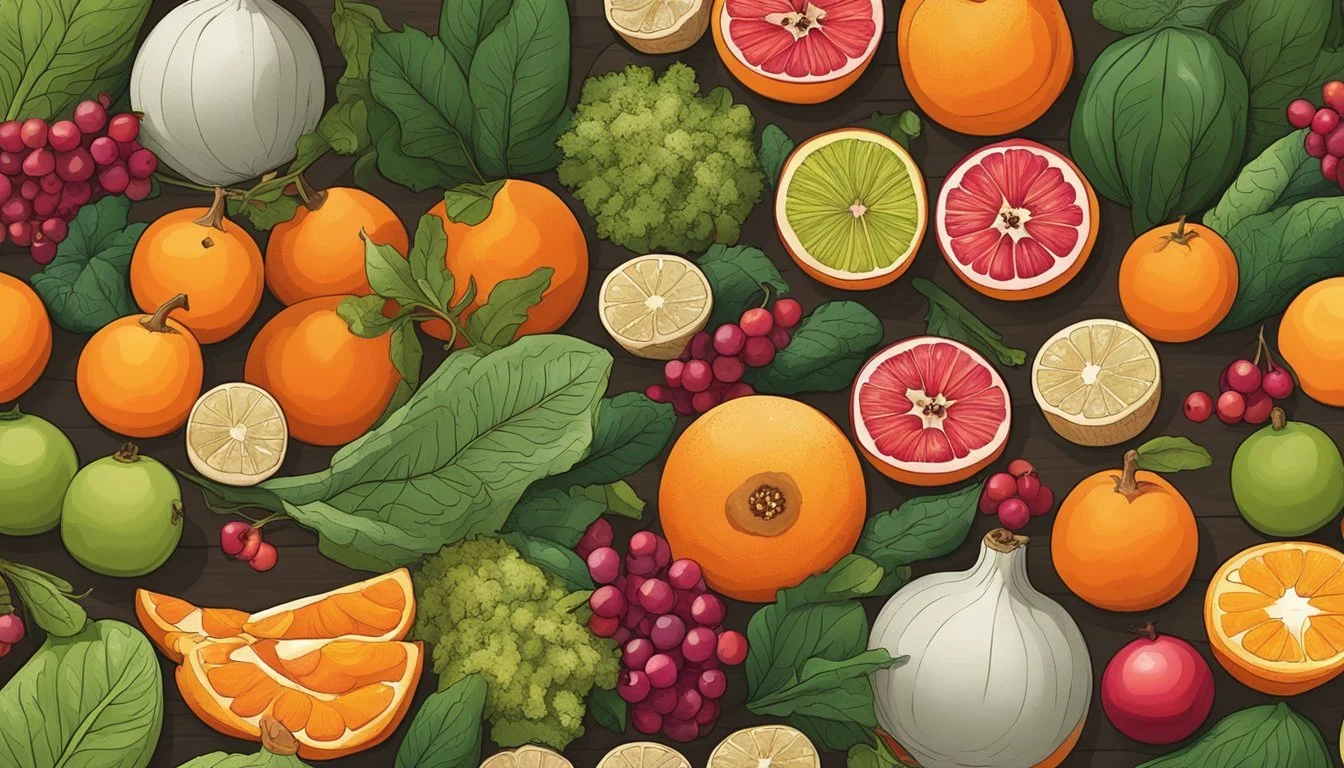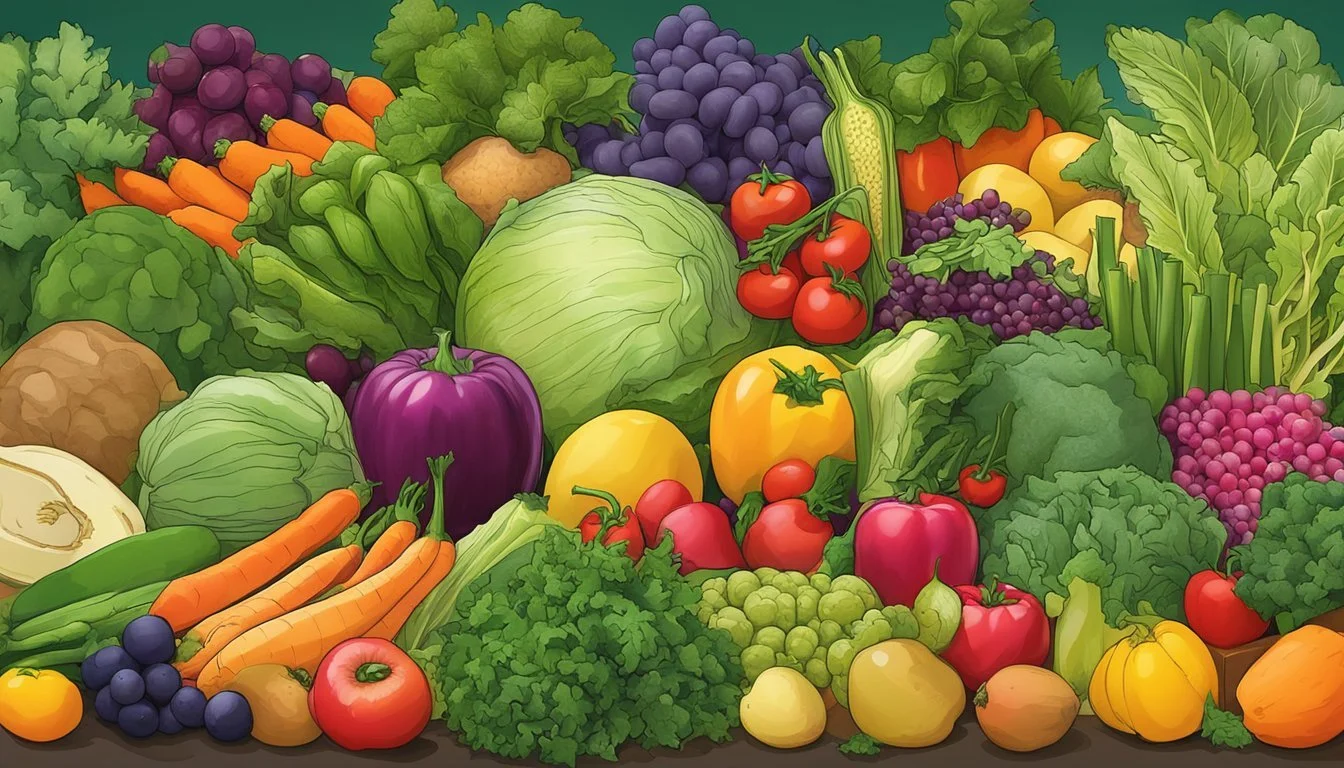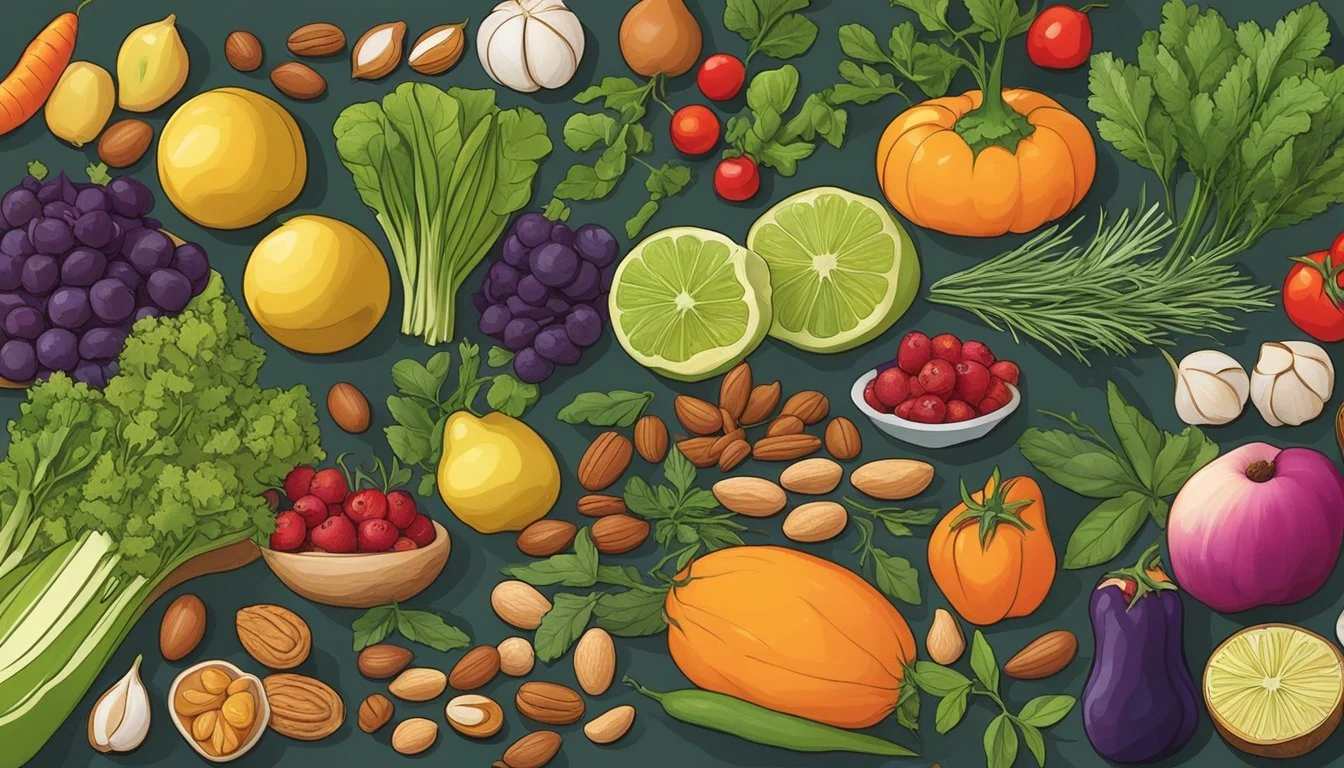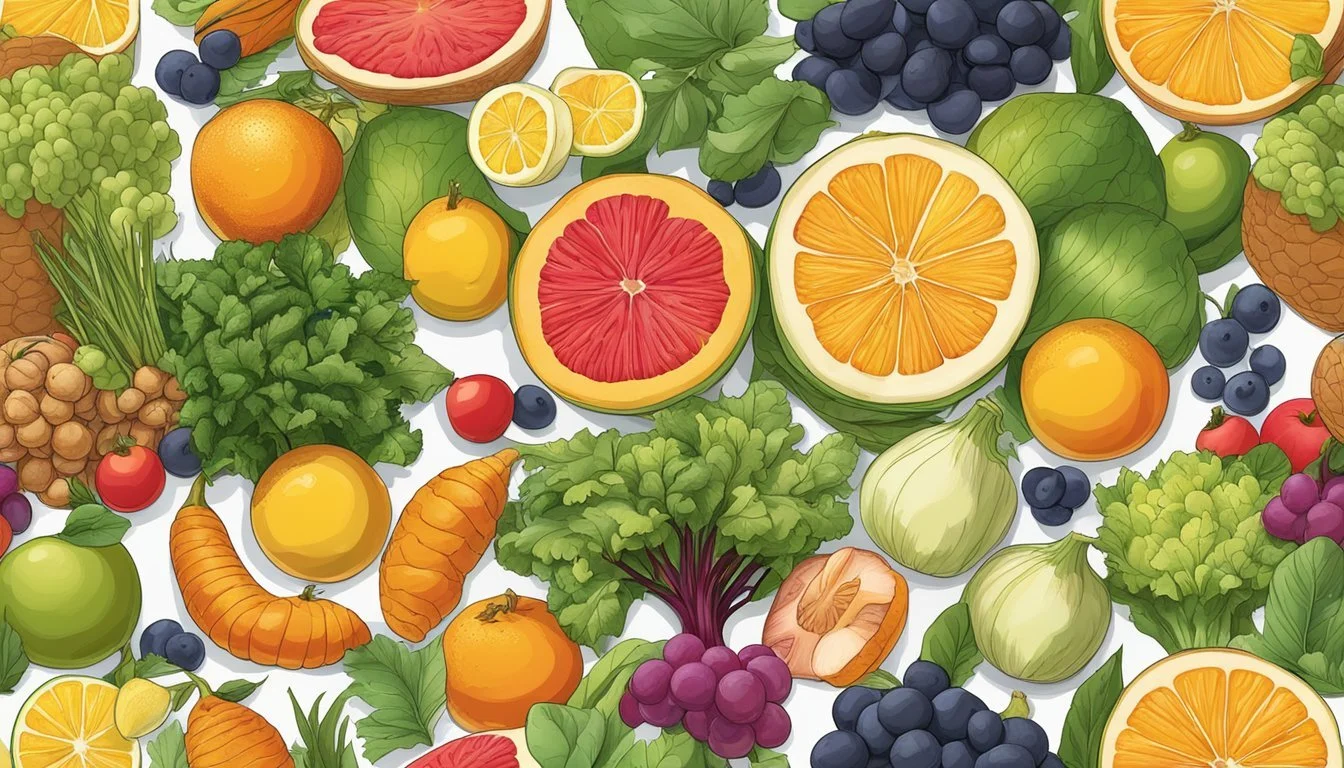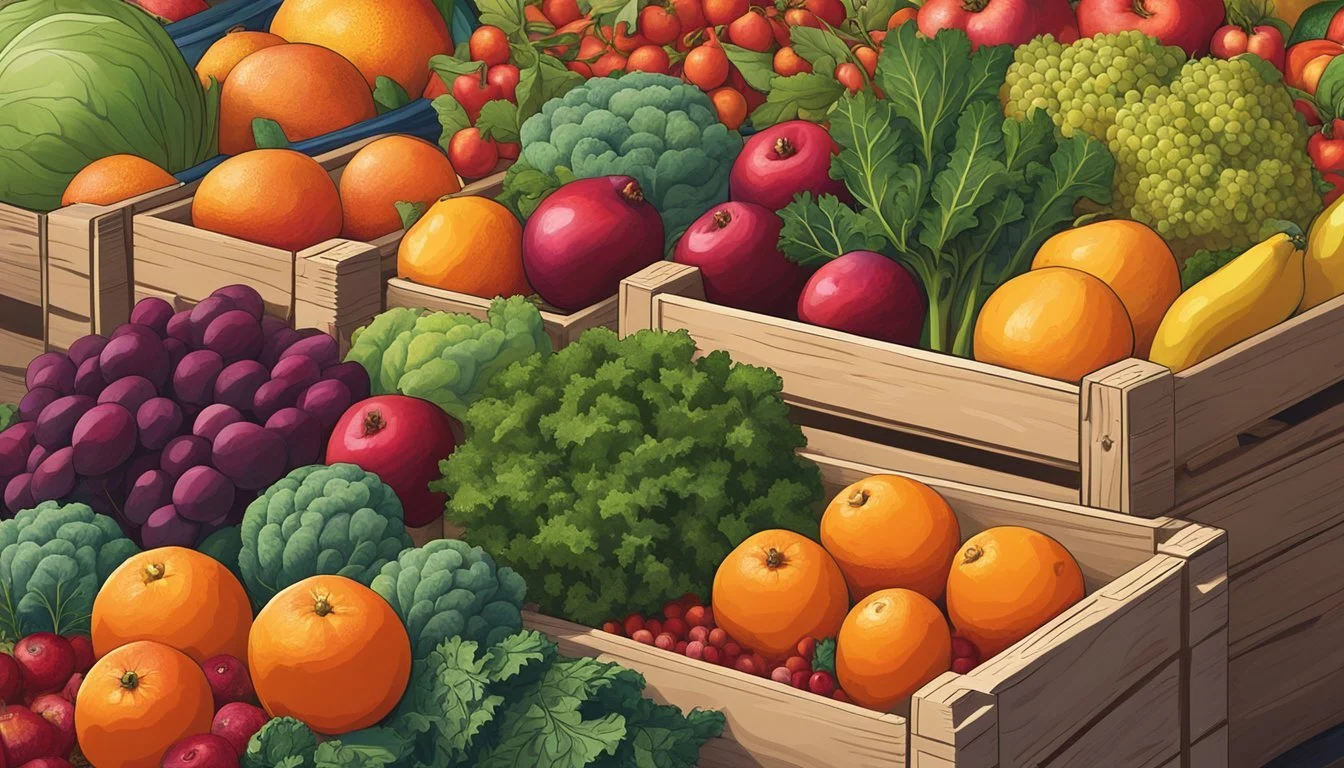California Seasonal Fruit & Vegetables in December
Your Fresh Produce Guide
This Article is Part of our California Seasonal Fruit & Veg Calendar
California is a rich agricultural hub that provides a diverse array of fruits and vegetables throughout the year, owing to its varied climate zones. In December, the state's produce selection adjusts to the cooler temperatures, offering seasonal delights that are both flavorful and nutritious. Consumers have the opportunity to enjoy fresh produce even in the heart of winter, with items that are traditionally harvested during this period.
Seasonal fruits available in December include citrus varieties such as oranges, grapefruits, and lemons, which are at their peak of sweetness and juiciness. Root vegetables like carrots and beets (how long do beets last?), along with winter greens such as kale (What wine goes well with kale?) and chard, thrive in the colder conditions, and are plentiful in the markets. Additionally, December is a prime time for consumers to find vibrant pomegranates and persimmons, which add a pop of color and a burst of flavor to winter dishes.
California's December produce is not only about the freshness but also about supporting local producers and consuming foods that align with the seasonal cycle. This ensures a lower environmental footprint and maximizes the nutritional value of the produce consumed. It reflects a conscious choice towards sustainability and the benefits of eating seasonally.
Seasonal Fruits Overview
In December, California's agricultural abundance continues with a variety of seasonal fruits, ripe and ready for the market. Shoppers can expect to find a wide array of fresh, flavorful fruits—from the vibrant citrus to the sweet and subtly exotic.
Citrus Fruits
Citrus fruits are a cornerstone of winter produce in California. The cool yet mild climate is ideal for:
Oranges: Navel oranges are particularly sweet and abundant in December.
Grapefruit: They are at their peak, with a perfect blend of tart and sweet.
Lemons: Eureka and Meyer lemons are readily available, ideal for culinary uses.
Tangerines: Easy to peel and super sweet, varieties like Satsuma are in season.
Blood Oranges: Sought after for their deep red flesh and unique flavor profile.
Shoppers can find these citrus fruits at local farmers' markets, boasting freshness and rich flavor.
Winter Berries and Pome Fruits
Although berries are typically associated with summer, some hearty varieties find their way into December:
Apples: Look for crisp varieties that store well through winter, like Fuji and Granny Smith.
Pears: Bartlett and Bosc pears are still available and perfect for festive desserts.
Subtropical and Other Fruits
A few subtropical fruits reach maturity in California's winters:
Persimmons: Two types, Hachiya and Fuyu, offer versatility in use from baking to fresh salads.
Avocados: Rich and creamy, they continue to be a staple in winter menus.
Kiwis: These can also be found, adding a vibrant green to the color palette of available fruits.
Each of these fruits adds its own unique taste and texture to the winter produce selection, making the season's offerings diverse and exciting.
Seasonal Vegetables and Greens
California's winter season brings a bounty of robust vegetables to local markets. Seasonal produce such as root vegetables and various greens thrive in the cooler temperatures, offering a fresh and nutritious selection for December.
Root Vegetables and Tubers
In December, root vegetables and tubers such as beets, potatoes, and sweet potatoes are harvested at peak freshness. Earthy and flavorful, turnips and radishes also enrich the seasonal array, each offering their unique taste and texture. Carrots, with their signature crunch and sweetness, are another staple found in Californian markets during the winter months.
Beets: Earthy, rich in color and nutrients
Potatoes: Versatile staple
Sweet Potatoes: Naturally sweet, vitamin-rich
Turnips: Slightly peppery taste, can be eaten raw or cooked
Radishes: Crisp and peppery
Carrots: Sweet and crunchy
Cruciferous Vegetables
This group of vegetables remains a winter favorite, known for their health benefits and hearty flavors. Broccoli, cabbage, Brussels sprouts (how long do brussels sprouts last?), and cauliflower are all in season. They can be found fresh in markets and are versatile for a range of dishes, from roasted sides to soups and stews.
Broccoli: High in vitamins, can be enjoyed raw or cooked
Cabbage: Great for slaws or cooked dishes
Brussels Sprouts: Nutty flavor, best when roasted
Cauliflower: Mild and adaptable to many recipes
Leafy Greens and Other Vegetables
Spinach, kale, and chard are leafy greens that are particularly robust during California's cool December climate. They bring not only a pop of green to the plate but also a wealth of nutrients. Artichokes (What wine goes well with artichokes?) are another seasonal vegetable that adds a unique flavor and texture to winter dishes.
Spinach: Tender and versatile
Kale: Sturdy and nutrient-dense
Chard: Colorful stems, earthy flavor
Artichokes: Distinctive taste, excellent for steaming or grilling
Farmers' markets and grocery stores will showcase these vegetables, embodying the fresh, seasonal produce available in California during December.
Herbs and Nuts in Season
In December, California's bounty includes a variety of herbs and nuts that are picked at their peak. They manifest the region's agricultural richness and culinary versatility.
Herbs in Season:
Basil: Even in cooler months, basil can thrive in California's milder climates. December's basil still carries its sweet, peppery essence, ideal for pesto or as a fresh addition to winter dishes.
Nuts in Season:
Almonds: With harvest typically ending in late fall, almonds are plentiful in December. They are enjoyed for their versatility and are a staple in holiday cooking and baking.
Walnuts: Another nut reaching the end of its harvest period in the fall, walnuts are available fresh in December. They provide richness to savory and sweet creations alike.
Pistachios and pecans also feature among the variety of nuts available during this month, perfect for festive treats or as nutrient-rich snacks.
It is essential to note that the actual availability can vary based on the specific climatic conditions of the year.
Consumers are encouraged to seek out fresh, locally-sourced herbs and nuts to ensure the best quality and to support California's agricultural community.
Seasonal herbs and nuts each carry distinct characteristics that can enhance a wide array of recipes, allowing culinary enthusiasts to experiment while utilizing the freshest produce of the season.
California Seasonal Recipes
December in California offers a variety of seasonal produce perfect for creating warm, comforting recipes that cater to the cooler climate. Utilizing fresh, local ingredients not only supports California's agriculture but also ensures that meals are packed with flavor and nutrients.
Hearty Stews: Utilize root vegetables such as carrots, potatoes, and parsnips to create rich and savory stews. These root vegetables lend themselves well to slow cooking, developing an enhanced sweetness and tender texture. Adding chunks of butternut or acorn squash contributes body and a touch of winter sweetness to any stew.
Fresh Salads: Even in winter, California provides. Fresh kale and collard greens stand out in crisp salads. For a festive touch, one can garnish with pomegranate seeds (how long do pomegranate seeds last?) for a burst of color and tanginess. These greens hold up well under bold dressings and can be paired with roasted nuts for added crunch.
Enlivened Pastas: Green vegetables like Brussels sprouts and broccoli can be sautéed with garlic and olive oil to make a simple, yet satisfying pasta dish. Meyer lemons, with their sweeter, less acidic flavor, can be zested over the top for a citrusy finish.
Winter Squash Pastas: Integrate cubes of roasted winter squash into pasta for a hearty dish. The caramelized edges of the squash enhance the pasta, and with a sprinkle of sage or rosemary, the dish takes on an aromatic quality that's perfect for December dining.
By choosing ingredients that are in season, chefs and home cooks alike can create meals that are both delicious and deeply rooted in California's seasonal bounty.
Shopping Tips for Seasonal Produce
When seeking out the freshest seasonal fruits and vegetables in California in December, consumers can find a variety of options at local farmers markets and grocery stores. Utilizing these venues to purchase December's bounty ensures that they receive high-quality produce while supporting local agriculture.
At farmers markets, individuals have the advantage of directly interacting with growers. Shoppers are encouraged to:
Ask questions: Farmers can offer insights on how their produce was grown and provide suggestions for the best storage and preparation methods.
Inspect the produce: Look for vibrant colors and firm textures, which are indicators of freshness and quality.
In grocery stores, the selection of produce may vary. Shoppers can utilize these tips:
Check for signs of freshness: Such as crisp leaves on vegetables and undamaged skins on fruits.
Look for local labels: As these are more likely to be in season and have traveled shorter distances, retaining their flavor and nutrients.
Regardless of the shopping venue, consumers can make more informed decisions by keeping the following in mind:
Plan ahead: Know what produce is in season to focus your search and avoid overwhelming decisions.
Be flexible: While having a grocery list is helpful, shoppers may find alternative seasonal items that are fresher.
Embrace variety: December offers an array of produce, including root vegetables and citrus fruits, which can add a seasonal touch to any dish.
Remember, choosing seasonal produce is not only about enjoying the peak flavors but also about contributing to the sustainability of local food systems.
Benefits of Eating Seasonally
Eating seasonally involves selecting fruits and vegetables that are naturally harvested at the time of consumption. One major benefit is the enhanced flavor and freshness. Seasonal produce is often picked at the peak of its ripeness, contributing to a better taste and higher levels of natural sugars.
From a nutritional standpoint, seasonal fruits and vegetables can be superior. They are harvested at their nutritional peak, which means they often contain more vitamins, minerals, and antioxidants. These nutrients support overall health, including strengthening the immune system and reducing the risk of chronic diseases.
Incorporating seasonal produce into recipes not only adds diversity to meals but also encourages a more balanced diet. A varied diet is linked to a lower risk of developing nutrient deficiencies and promotes a broader intake of essential nutrients.
Consumers who eat seasonally can also benefit from the economic advantage. Seasonal produce is often more affordable because it is abundant and costs less to harvest and transport. Therefore, individuals can buy more for less, facilitating a healthier diet without straining their budget.
Lastly, eating seasonally supports the local economy and reduces the environmental impact associated with long-distance transportation of non-seasonal produce. Purchasing from local farmers ensures that one contributes to the sustainability and vitality of the community's agricultural base.
Understanding California's Seasons
California's diverse climate dramatically influences its agriculture, creating a unique schedule for harvesting crops. With a focus on December produce, this section outlines the environmental effects on seasonal yields and provides a detailed harvest calendar.
Climate Influence
California's agricultural success stems from its varied microclimates, ranging from Mediterranean to desert-like conditions. These climate zones affect the growth and seasonality of fruits and vegetables. Winter Squash is an example of a crop that thrives in California's winter months, which run from late October to March. During December, the cooler and sometimes wetter climate of the state contributes to the optimal growth of such vegetables, ensuring they are abundant and at their peak quality.
Harvest Calendar
A concise harvest calendar aids in understanding the availability of California seasonal produce. In December, consumers can expect a range of fresh products:
Winter Squash: Available from late fall into winter.
Citrus Fruits: Including oranges, lemons, and grapefruits; peak in winter.
Leafy Greens: Such as kale and chard; thrive in cooler weather.
Root Vegetables: Like beets and carrots; harvested in the colder months.
Here's a simple December snapshot for better clarity:
Produce Type Harvest Period Notes Winter Squash October - March Includes varieties like butternut and acorn squash Citrus Fruits December - June Best consumed when fully ripe Leafy Greens October - May Ideal in cooler temperatures Root Vegetables October - April Includes beets, carrots, and turnips
This schedule shifts as the seasons progress, with a noticeable turnover in available produce as one moves into the summer months. However, in December, the listed items are just a segment of California's bountiful offerings.
Conclusion
In December, California's bounty continues to impress with a variety of fresh produce. Farmers' markets and grocery stores showcase a colorful selection, maintaining the state's reputation as a year-round provider of fruits and vegetables.
Fruits:
Citrus: Oranges, lemons, grapefruits, and tangerines are vibrant and in full swing.
Persimmons: Sweet and ripe, perfect for holiday recipes.
Vegetables:
Leafy Greens: Varied kinds like kale and chard thrive in cooler temperatures.
Root Vegetables: Carrots and beets are earthy and nutritious additions.
The agricultural techniques and climate in California support these crops well into the winter months, ensuring consumers have access to fresh and seasonal options. This period also signifies a time when robust flavors are abundant, adding warmth to dishes during cooler days.
It is clear that California's diverse environments foster a unique growing climate, permitting residents and visitors alike to savor local flavors even as the year winds down.


